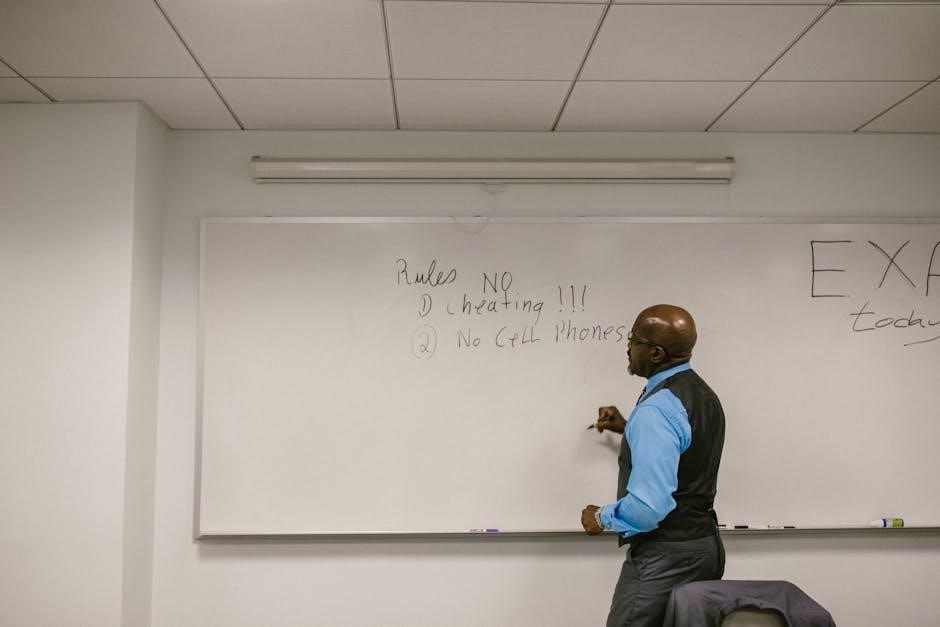rules of divisibility pdf
Divisibility rules are essential tools in mathematics, enabling quick determination of whether a number can be evenly divided by another without performing actual division. These rules simplify mental math, problem-solving, and computational applications, making them universally valuable for students and professionals alike.

Fundamental Concepts of Divisibility
Divisibility is the ability of a number to be divided by another without leaving a remainder. It involves understanding factors, multiples, and basic arithmetic principles to simplify calculations.
What is Divisibility?
Divisibility refers to the ability of one number to be divided by another without leaving a remainder. It is a fundamental concept in arithmetic, defining whether a number is a multiple of another. For example, 12 is divisible by 3 because 12 ÷ 3 = 4, with no remainder. A number is divisible by another if the division results in an integer. This concept is crucial in understanding factors and multiples, forming the basis for various mathematical operations and problem-solving techniques.
Importance of Divisibility in Mathematics
Divisibility is a cornerstone of mathematics, simplifying the process of checking whether a number can be evenly divided by another. It aids in identifying factors and multiples, which are crucial in various mathematical operations. Divisibility rules enhance mental math capabilities, enabling quick calculations without actual division. They also play a key role in real-world applications, such as finance, engineering, and computer science, where efficient problem-solving is essential. Understanding divisibility fosters a deeper appreciation of number properties and their interrelationships, making it a vital skill for students and professionals alike.
Factors and Multiples: Basic Concepts
A factor of a number is an integer that divides it exactly without leaving a remainder, while a multiple is the product of that number and any integer. For example, factors of 6 are 1, 2, 3, and 6, and its multiples are 6, 12, 18, etc. Understanding factors and multiples is fundamental in mathematics, as they form the basis for divisibility rules and are essential in solving problems involving ratios, proportions, and algebraic expressions. They also have practical applications in real-world scenarios, such as budgeting and engineering.
Common Divisibility Rules
Common divisibility rules include checking the last digit for 2, 5, and 10, summing digits for 3 and 9, and examining the last two digits for 4 and 6.
Rule for 2
A number is divisible by 2 if its last digit is even (0, 2, 4, 6, or 8); This simple rule allows quick verification without full division. For example, 123,456 ends with 6, an even digit, making it divisible by 2. This rule is fundamental for mental math and real-world applications, such as checking even distribution or pairing items efficiently. Its simplicity makes it one of the most commonly used divisibility tests in everyday problem-solving scenarios.
Rule for 3
A number is divisible by 3 if the sum of its digits is divisible by 3. For example, 123,456 has a digit sum of 1+2+3+4+5+6 = 21, which is divisible by 3. This rule is highly practical for mental math and quick checks. It works by reducing the number to a smaller, manageable sum, making it easier to determine divisibility without performing full division. This method is widely used in everyday calculations and educational settings to enhance problem-solving efficiency.
Rule for 5
A number is divisible by 5 if its last digit is either 0 or 5. For example, 10 and 15 are divisible by 5 because they end in 0 and 5, respectively. This rule is straightforward and applies universally, regardless of the number’s size. It simplifies quick checks and mental math, enhancing efficiency in various mathematical applications. The rule works because multiples of 5 end in 0 or 5, making it a reliable method for determining divisibility by 5 without performing full division.

Rules for 4, 6, 7, 8, 9, 10, 11, and 12
Divisibility by 4: Check if the last two digits form a number divisible by 4. For 6, the number must be divisible by both 2 and 3. 8 requires the last three digits to be divisible by 8. 9 involves summing all digits; if the sum is divisible by 9, so is the number. 10 checks if the number ends in 0. For 11, subtract the sum of the digits in odd positions from the sum of the digits in even positions; if the result is divisible by 11, so is the number. 12 combines the rules for 3 and 4, ensuring divisibility by both.

Advanced Divisibility Rules
Advanced rules apply to higher numbers like 7, 13, 17, and 19, involving unique tests such as alternating sums or specialized algorithms. These rules extend to composite numbers and different numerical bases, offering deeper insights into number theory and its practical applications in mathematics and computer science.
Rule for 7
To check if a number is divisible by 7, take the last digit, double it, and subtract this value from the remaining part of the number; If the result is divisible by 7, then the original number is also divisible by 7. For example, for 161:
– Last digit: 1
– Remaining number: 16
– Calculation: 16 ⎼ (1 × 2) = 14, which is divisible by 7.
This rule simplifies testing divisibility without actual division, making it a handy tool for mental math and quick calculations. Its practical applications extend to various computational and educational contexts.
Rule for 13
The divisibility rule for 13 involves an alternating sum of blocks of three digits. Starting from the right, group the number into sets of three digits. Add and subtract these groups alternately. If the final result is divisible by 13, then the original number is also divisible by 13. For example, for 247:
– Group: 247
– Calculation: 247 is directly divisible by 13 (13 × 19 = 247).
This method is particularly useful for larger numbers and offers a systematic approach to verifying divisibility without lengthy calculations.
Rules for 17 and 19
The divisibility rules for 17 and 19 involve specific operations on the digits of the number. For 17:
Multiply the last digit by 5.
Subtract this product from the rest of the number.
If the result is divisible by 17, the original number is also divisible by 17.
For 19:
Multiply the last digit by 2.
Add this product to the rest of the number.
If the result is divisible by 19, the original number is divisible by 19. These rules are particularly useful for mental math and quick verification of larger numbers without actual division.
Divisibility Rules for Composite Numbers
Divisibility rules for composite numbers often combine the rules of their prime factors. For example, to check divisibility by 4, examine the last two digits; if they form a number divisible by 4, the entire number is divisible by 4. For 6, a number must be divisible by both 2 and 3. Similarly, for 9, the sum of the digits must be divisible by 9. These rules simplify testing divisibility for larger composite numbers by breaking them down into their prime components, making mental math and quick verifications more efficient and accurate.
Divisibility in Different Bases
Divisibility rules are not confined to base 10; they can be applied across various numeral systems. In base 2 (binary), for instance, a number is divisible by 2 if its last digit is 0. In base 16 (hexadecimal), rules adapt to the higher base, with unique patterns emerging. Understanding divisibility in different bases enhances computational applications and algorithm design, as many programming languages utilize bases beyond decimal. This versatility underscores the universal applicability of divisibility principles, tailored to the specific characteristics of each base.

Practical Applications of Divisibility Rules
Divisibility rules are widely used in mental math, education, and computational tasks. They enable quick checks for divisibility without actual division, enhancing problem-solving efficiency in real-world scenarios and academic settings.
Mental Math and Quick Calculations
Divisibility rules are invaluable for mental math and quick calculations, enabling individuals to determine if a number can be evenly divided without performing actual division. For example, the rule for 2 involves checking if the last digit is even, while the rule for 3 requires summing the digits and seeing if the result is divisible by 3. These techniques simplify complex problems, making them easier to solve mentally. They are particularly useful in everyday situations, such as splitting bills or calculating quantities, enhancing problem-solving speed and accuracy.
Real-World Examples and Problem Solving
Divisibility rules offer practical solutions to real-world problems, streamlining tasks like budgeting, cooking, and construction. For instance, determining if 24 eggs can be evenly divided among 4 people uses the rule for 4. Similarly, checking if a recipe requiring 18 apples can be halved uses the rule for 3. These applications demonstrate how divisibility rules simplify decision-making and resource allocation, making them indispensable tools in daily life and professional settings.
Education and Learning Benefits
Mastering divisibility rules enhances mathematical fluency and problem-solving skills, particularly in foundational arithmetic. These rules help students identify patterns and relationships between numbers, fostering a deeper understanding of numerical concepts. By simplifying complex divisions, they make mental math more accessible, boosting confidence and speed in calculations. Educators use these rules to engage learners, promoting logical thinking and critical reasoning. This foundational knowledge not only strengthens math proficiency but also prepares students for advanced topics like algebra and calculus, ensuring long-term academic success.
Computational Applications
Divisibility rules play a crucial role in computational applications by enabling efficient algorithms for number theory and modular arithmetic. They optimize tasks like factoring, primality testing, and error detection, ensuring faster processing. For instance, checking divisibility by 2 or 5 involves simple digit checks, reducing computational complexity; These rules are integral to data compression and encryption, where quick validations are essential. By streamlining operations, divisibility rules enhance performance in machine learning, databases, and real-time systems, making them indispensable in modern computing and algorithm design.


